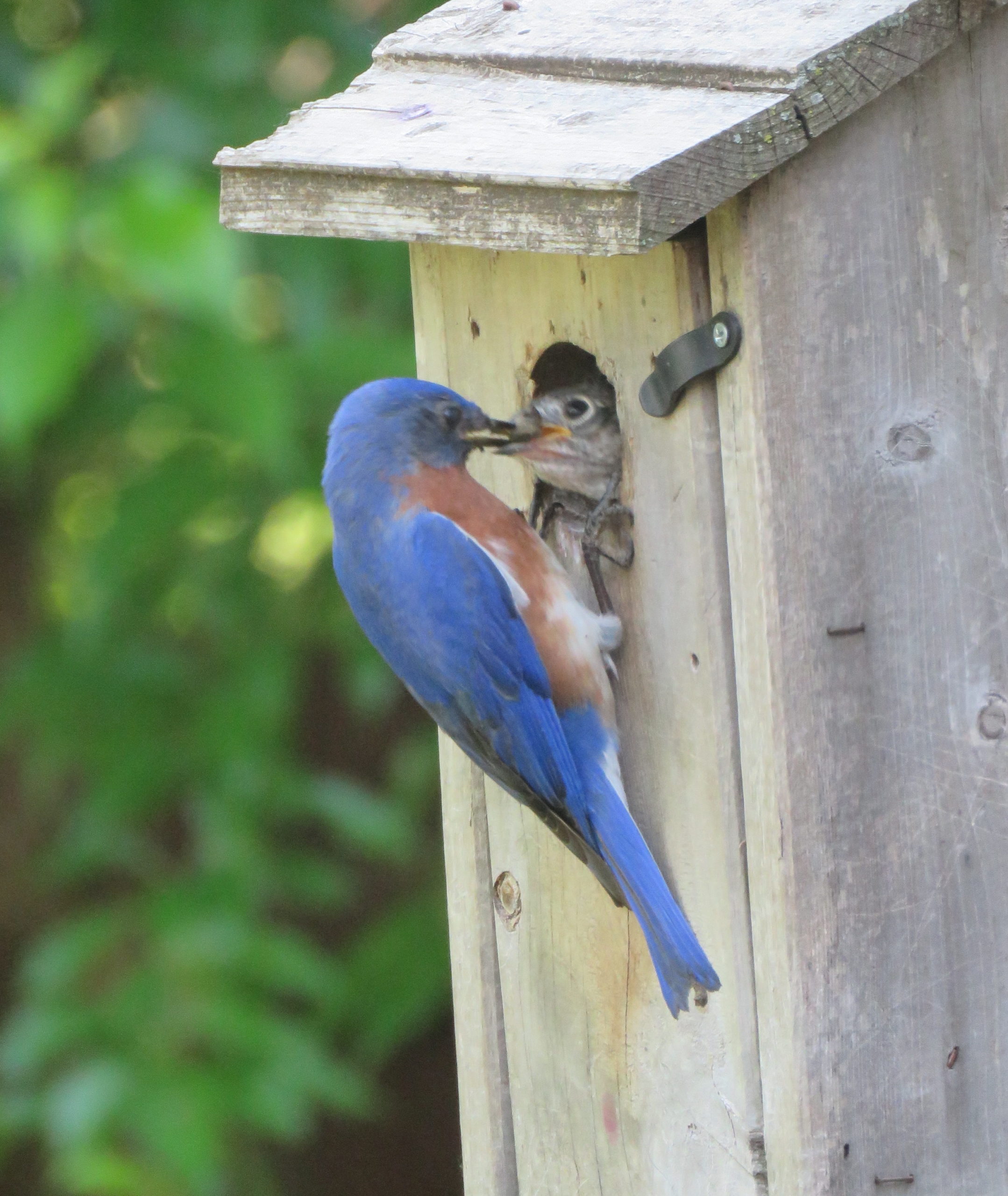Through our dining room window, my husband and I watched a variety of birds visit our backyard over the years. Robins, finches, wrens, even woodpeckers enchanted us with their beauty and songs. But we were never graced with a bluebird until we learned you have to draw them in.
One spring day, Gary bought a bluebird house from a hardware store and mounted it atop a metal pole about ten feet high beside our deck. The plain, wooden box was about the size and shape of a loaf of bread, with a slanted roof and round hole about two inches in diameter. I wondered how bluebirds would know it was for them, rather than sparrows or chickadees. Apparently, they are smarter than I thought.
Soon, a pair of bright blue birds appeared and perched on the roof. According to my bird book, the more colorful one was the male, and I named him Lapis, for the deep-blue metamorphic rock (Lapis lazuli) used as a semi-precious stone. His sapphire hue was exquisite, like a jewel against the backdrop of green trees and pale azure sky. The female, who was a little grayer but still quite lovely, I called Lazuli, or Zuli for short. Both had reddish orange breasts and white bellies.
For several days, they came and went, inspecting the birdhouse inside and out, before finally making a commitment. Toting bits of dried grass and twigs in their beaks, they would fly quickly and precisely through the circular opening, deposit their nesting material, then zoom away to fetch more. Sometimes, Lapis would take a twig out of the box and drop it on the ground. Perhaps she preferred softer grasses. After all, she was the one who would be sitting on the nest.
Then their habits changed. We could see Zuli’s head poking out of the hole most of the day, her black eyes bright and her beak slightly open during hot afternoons. Occasionally, she flew off to feed, but usually she nested for long hours while Lapis brought her earthworms dangling from his beak along with insects, even a bright yellow butterfly.
Since Gary and I are retired, we had ample time to observe. They were fearless, attacking squirrels, starlings, blue jays and other potential predators. The predators got the message and even abandoned efforts to bathe in our birdbath. House finches were welcome, even allowed to perch on the birdhouse roof, so they must have been relatives or at least good friends.
Early one evening, I noticed Lapis and Zuli on the deck railing, chattering and flapping their wings frantically. Gary investigated and discovered a long, gray snake twisting at the bottom of the pole. With a stick, he nudged the snake across the yard, where it slithered to the hayfield beyond. We hoped Lapis and Zuli realized we were allies. But whenever we stepped onto the deck, they dive-bombed us. After Gary started bringing them mealworms, they seemed to tolerate and even welcome us.
Then once again, their habits changed. Lapis and Zuli started toting fat slugs and bugs through the entrance hole. Soon they only needed to bring them to the edge of the entrance, where two gray heads with bright yellow, wide-open beaks begged for food. I named them Dewey and Molly. Sometimes the siblings pecked at each other, competing for each morsel. We set up a camera and spent much time watching them now, hoping to see them fledge.
And we were rewarded. While sitting at our dining table one evening, we saw Dewey (or maybe Molly), dart out through the opening and sail a few feet to the deck floor. The tiny bird, covered in grayish-brown feathers with white splotches, staggered around on big, wobbly feet, flapping its wings, trying out new body parts like a toddler. Mom and Dad watched from their perch on the railing.
Finally, Dewey/Molly stretched its wings and flew low above the deck and between the railings. Then it plummeted to the ground below. In the grass, where the snake might lurk. Gary reminded me that the bird was a wild creature and we should let it take its chances.
We returned to our dinner in time to see the second chick emerge from the opening and soar gracefully to a hedge apple tree branch. In a moment, the entire family was out of our sight.
For the next few days, we watched, hoping they would return to visit the old homestead. But they did not.
The blue jays and squirrels returned to splash in the birdbath. Gary emptied the bluebird house, discarding the nest with its shards of pale turquoise eggshells. He scrubbed the interior and left the hinged door open so the house could dry out. Gary and I found ourselves frequently gazing out the window, trying to accept the fact that, 15 years after our son was launched into the wide world, we were again empty nesters.
Bluebirds have appeared every year since then, either Lapis and Lazuli or their descendants. They build their nests, bit by bit. They struggle to tote fat slugs to their babies’ open beaks. They fight off squirrels and starlings. They are no doubt exhausted by all their labors. Some years they come twice, raising two broods.
They remind us of the joy of youth and renewal. And of life’s magic.
Contact Sherry Buettgenback at slbuettgenbach@gmail.com.









